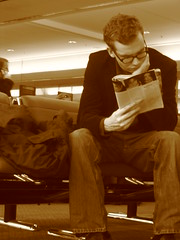Narrationless stories
Read David Kattenburg's The Art of the Narrationless Documentary tonight, and was reminded of something I read in Ira Glass's Manifesto on Transom.
Early in his career, Ira "invented this series of stories where I'd interview people and then edit myself out of the tape completely. They'd tell stories and reflect on what the stories meant. No script. No narration."
Which is a nice idea. I like hearing people tell their own stories. You know those introductory segments on TLC's A Wedding Story? The ones where the bride and groom each explain how they met and fell in love? The stories would be intercut, often with touching or humorous results. Though I hate to admit my original point of reference, I love that technique. I employed it over the summer in a story I did about a guitar prodigy. I got him and his mom to tell the same story (how he got his first guitar) at different times, then spliced the two together. Even though they weren't even in the same room, they played off each other wonderfully. I was really pleased with the end product.
But I disagree when Kattenburg says that narrationless stories are "free from journalistic meddling." He goes on to explain that "the three key tasks for the narrationless documentarist are editing, editing and editing." Editing is a big component of journalism. Meddling might be too strong a word, but I don't think narrationless stories approach the level of pure objectivity that Kattenburg suggests. If you're doing an interview, you're doing an interview, and cutting yourself out of the tape can't change that.
Ira's suggestion? Embrace the reporter's voice in interviews. From Part One of his Manifesto:
Like most beginning radio reporters, I didn't like to hear myself on tape. I didn't like how I sounded asking the questions. So much of the time I was awkward or cloying. Trying too hard in one way or another. It was embarrassing. But at some point I decided that omitting this kind of tape meant I was accidentally omitting a kind of drama from my stories, neglecting some of the tools at my disposal, neglecting part of the power and fun of the medium, and I forced myself through it, in story after story. Even today, if I had to give just one piece of advice to beginning reporters about the single fastest way they could improve their stories, it'd be to get themselves into the quotes. Asking tough questions. Cajoling the interviewee. Joking with the interviewee. Thinking out loud and chatting with the interviewee. The daily reporting on public radio would be so much more fun to listen to, and so much more informative about the character of the interviewees, if there were more of this.There are lessons to be learned from both arguments. Personally, I prefer narrated stories, with (if you can achieve a good string of "perfect matches") narrationless clips islands. Remember that an on-tape interviewer can be part of the "artful juxtaposition of voices." Maybe it's the Hunter S. Thompson in me, but I think the reporter/interviewer is part of the story by definition. Listeners should be made aware of that.




0 Comments:
Post a Comment
<< Home